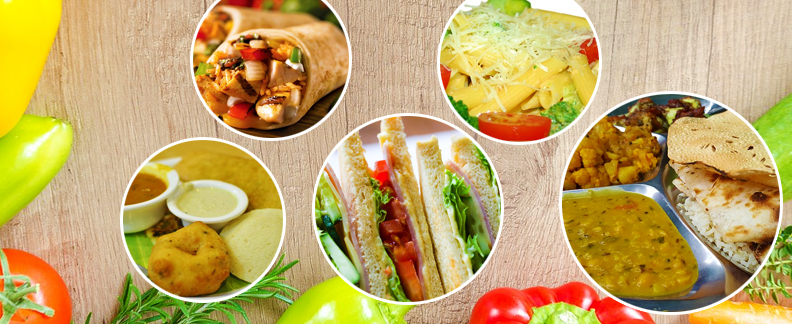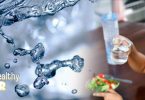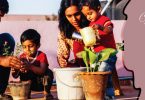When should this start? From birth, but practically from the age of 5 upwards. The miracle fitness formula – Walk, Water, Diet is applicable to children as well.
Water: Due to highly reduced physical activity today, people are drinking much less water and children prefer to drink all the commercially advertised fizzy drinks, juices, shakes, etc. Please note, nothing can substitute the plain water need of your body. Children 5-8 years of age need at least 1½ litres, 8-12 years – 2 litres and 12 and above 2½ litres of plain water daily. Water keeps you alert, fresh and clean. Less water makes you slow and sluggish and your mouth and body will smell offensive. Research shows that when the body is fully hydrated the brain works more efficiently with mathematical calculations. We all want our children to be good at maths!
Diet: Parents must set good examples of healthy eating for children. The biggest rule is to never skip meals and especially never skip breakfast. The second big rule is to encourage all kids to eat fresh fruits and vegetables (salad) daily. Raw fruits and vegetable are the richest source of vitamins and minerals and also fibre. It is absolutely a must for building resistance to infection and also for the smooth running of all systems.
Control Fatty food intake: The secret here is not to forbid it but to budget it. Nobody, young or old can get away with eating fatty food daily. Chocolates, chips, pastry, ice-cream, pizza, burgers etc., are delicious and exciting for kids. But parents must supervise the buying and eating of these and ensure that it is strictly limited to 1-2 times a week; never more.
| “Can a person determine their identity and worth or value depending on the ‘Likes’ that they earn on some social networking site?” |
Healthy Menu Plan for Kids
A proper balance of nutrients namely carbohydrate and protein is very important to ensure good growth and also prevent unhealthy eating habits from setting in now. In such cases what we normally see is that the protein in the diet may be quite low and hence the children get hungry and the stomach feels empty an hour or so after a meal and they start looking out for chocolates and sweets.
Breakfast – It is very unhealthy to begin your day without breakfast. A child on an empty stomach will not be able to concentrate in class and think clearly. He may get moody and bad tempered with other children. Even if you have to wake up your child 15 minutes earlier you must see that he does not leave the house without eating.
Only a glass of milk for breakfast is not balanced. Milk plus 2 slices of bread or cereal and milk or porridge with milk would be ideal. Similarly, milk and egg alone are only protein foods. Milk and egg along with bread or chapati would be ideal. Bread and jam or bread and butter alone is not good as the protein is missing. Egg or milk must go with it. Iddli and sambar or dosa are good as they are in themselves a rice and dhal combination. If the child has to leave the house before 7 am then at least a glass of milk and a small banana should be given before he leaves the house. The 10 am break tiffin should carry his breakfast. Kindly note that raw eggs are useless in terms of protein as the egg cannot be digested by the human body unless it is fully cooked. If eaten raw it is completely excreted from the body.
Lunch: Do not send only snacks for lunch. Lunch must be a balanced meal. They must learn from a young age that breakfast and lunch are proper meals and not get into the habit of light eating or snacking in the earlier part of the day and heavy eating in the evenings, which is one of the major factors contributing to the great rise in incidents of ob esity, diabetes, heart disease, etc. Most often lunches and dinners are also poorly balanced. Lime rice, tamarind rice or pulav alone gives only carbohydrates. Sabji and chapathi again are both from the carbohydrate group with protein missing. Dhal, pulses, non-veg, egg or curd must be given with the above. If chapathi is sent then a thick dhal or channa or rajma should be sent with it along with a sabji. Chapati rolled with vegetable and shredded non-veg, egg, paneer etc. These combinations are important to give a carbohydrate plus protein balanced meal. This lunch meal must be eaten in the school between 12 noon to 1pm. (not at 3 or 4pm when the child comes home from school.)
Teatime: Do not serve lunch at 4 pm, it is teatime. Lunch should be eaten at school during lunch time. When they return from school care must be taken to see that a glass of milk and a healthy snack like sandwiches, etc. are provided. Sandwiches may be made of vegetables, jam and egg or cheese occasionally. After play at 6pm, a fruit is a must.
Dinner: Dinner is a balanced meal again. Roti or rice with dal or pulses and a vegetable dish must be the base. Curds and non-veg can be added and a salad has to be served with dinner. If making a continental dinner, the balance must be right. Pasta must be served with some vegetables and white sauce, cheese or egg. The white sauce, cheese or egg are the protein foods and must be included always. If serving non-veg at night, restrict the quantity and serve it only 2-3 times per week. It may be eaten more often at lunch time.
Remember food should be distributed as breakfast + snack 40%, lunch + tea 40% and dinner 20%. If it is breakfast 0-10%, lunch 20% and dinner 70%, you are paving the way for obesity and other diseases.






Leave a Comment